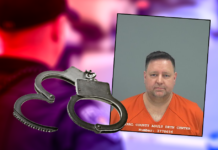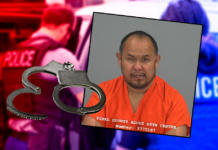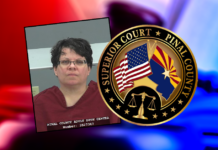Chelsea Cunningham has seen her share of injuries.
The 28-year-old Canadian said she’s been “on scene” for cuts, bruises, head injuries and falls. That’s when her first-aid knowledge is put to the test.
But the mother of three isn’t a first responder or a registered nurse. Her reason for taking classes on how to provide medical care is simple.
“If you get out and live – stuff happens,” she said.
Last Saturday, when Cunningham went to a farmer’s market south of Maricopa with her children, “stuff” certainly did happen. She was one of three people who helped save the life of a toddler who fell into a sewage tank nearby.
First responders say the situation could have ended much differently had Cunningham not administered CPR – a skill she learned through taking classes.
“This is the first time (I had) to utilize the CPR skills,” she said Thursday at Fire Station 574 in Maricopa. Firefighters invited Cunningham and her family to tour the station. She met with members of the crew who responded to the scene as well as Fire Chief Brady Leffler.
“Having that CPR knowledge – it proves it right here – it absolutely saves lives,” said Engineer Larry Walker, who was part of the crew that responded to Saturday’s incident.
Walker said when he arrived at the farmer’s market on West Papago Road with first responders James Carlisto, Osheah Davis and Joel Wainwright, the toddler was breathing.
“They did all the work,” said Walker, referring to Cunningham and two other men – Henry Ricketts and Audencio Rios – who pulled the child from the tank. “They saved the little girl’s life. If they hadn’t done the measures that they’d done, the outcome would not have been good. All the credit goes to them.”
Capt. Richard Jackson said in critical situations such as these – especially when a child is involved – time is of the essence.
“They don’t move as much volume and circulate as much blood,” Jackson said, who added the CPR that was administered by Cunningham made a difference.
Authorities say the child, Kylie Howard, was under raw sewage for about four minutes. When Cunningham first laid hands on the baby, the child was not breathing.
“She came out – no vitals, no breathing,” Cunningham said.
Shortly after Cunningham began administering CPR, the child began to breathing, according to authorities.
According to the American Heart Association, most Americans don’t know how to perform CPR. The AHA recommends that in situations where a teen or adult has collapsed, a person should immediately call 911 and start performing “hands-only” CPR, or CPR performed without mouth-to-mouth breaths. For infants and children, AHA recommends administering short, gentle breaths between chest compressions.
Cunningham, who is from Sundre, a small town in the Canadian province of Alberta, said she becomes re-certified in CPR and first-aid about every year and a half. Growing up, there was a “strong first-aid presence” in her home, she said.
Her dad worked in the correctional system and had to know such skills.
When asked where she has used her first-aid skills in the past, Cunningham responded: “Life.”














![Affordable apartments planned near ‘Restaurant Row’ A blue square highlights the area of the proposed affordable housing development and "Restaurant Row" sitting south of city hall and the Maricopa Police Department. Preliminary architectural drawings were not yet available. [City of Maricopa]](https://www.inmaricopa.com/wp-content/uploads/2024/04/041724-affordable-housing-project-restaurant-row-100x70.jpg)


